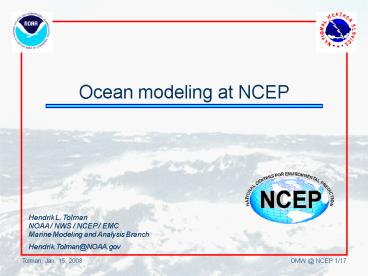Ocean modeling at NCEP - PowerPoint PPT Presentation
1 / 17
Title:
Ocean modeling at NCEP
Description:
NOAA / NWS / NCEP / EMC. Marine Modeling and Analysis Branch. Hendrik.Tolman_at_NOAA.gov ... North Atlantic grid with 4-7km US coastal resolution (ETOPO2, NGDC) ... – PowerPoint PPT presentation
Number of Views:106
Avg rating:3.0/5.0
Title: Ocean modeling at NCEP
1
Ocean modeling at NCEP
Hendrik L. Tolman NOAA / NWS / NCEP / EMC Marine
Modeling and Analysis Branch Hendrik.Tolman_at_NOAA.
gov
2
RTOFS-Atlantic
1
- HYCOM application
- Primitive equation with free surface.
- Sub-grid scale parameterizations. Vertical and
horizontal eddy viscosity and mixing. Diapycnal
mixing. - Tides river outflow (USGS, RIVDIS).
- Atmospheric fluxes (GFS).
- North Atlantic grid with 4-7km US coastal
resolution (ETOPO2, NGDC) - Open boundaries T,S from climatology
- SSH and barotropic velocity from tidal model
(TPX06) and climatology.
3
RTOFS-Atlantic
2
4
RTOFS-Atlantic
3
- 2007 model updates
- Revised vertical grid to 26 layers
- Higher resolution in the shallow waters.
- Better resolution on the shelf break.
- Better representation of Denmark Iceland
overflows. - Resolving 4 vertical dynamical modes in major
sub-basins - Improved barotropic / baroclinic inputs at open
boundaries - Updated Climatology (NCEP version 6)
- Mean dynamic topography (Rio 5)
- Historical transports
5
RTOFS-Atlantic
4
- 2007 model updates conted
- Revise river inflow data (location and strength)
from USGS - Remove noise in net heat flux
- Update of model algorithms
- Surface initialized Montgomery Potential
- Employ two invariant external mode boundary
conditions. - Stabilization of sigma_star.
- Enforced salinity minimum by refreshing the water
column
6
RTOFS-Atlantic
5
- 2007 model updates conted
- Major upgrades to data assimilation
- SST spatially varying bias removal algorithm
- SSH absolute sea surface height
- 2D 1D approach, conserving momentum.
- TS assimilation of vertical profiles of
temperature and salinity - 2D density, temperature and layer thickness
anomaly, preserves volume, momentum updates
mass and heat. - New model output
- GRIB files on native grids.
- GRIB files sets for selected sub-regions.
7
RTOFS-Atlantic
6
- SSH without (upper-left panel) and with SSH
assimilation (lower-left panel) from
RTOFS-Atlantic - Data JASON, GFO and RIO5 mean dynamic
topography. - U. of Colorado analyses. Uses also ENVISAT data.
8
RTOFS-Atlantic
7
Mean Gulf Stream path from old model (left) tends
to overshoot the annual mean path derived from
altimetry data near 72? W as compared to the
Gulf Stream location in the new implementation
(right)
9
RTOFS-Atlantic
8
- Product distribution
- FTP site (ftpprd)
- Nowcast and 5-day forecasts available for 3 days.
- NOMADS server
- Nowcasts and 5-day forecasts available for 30
days. Tools to extract sub-regions available. - Targeted to become operational in 2008.
- NODC Archives
- Long term archival. Under construction.
10
Coupled HWRF-HYCOM
1
IC/BC
HWRF O(9 km)
GFS O(25 km)
interaction
RTOFS (HYCOMBasin) O(417 km)
Hurricane (HYCOMRegional) O(814 km)
IC/BC
11
Coupled HWRF-HYCOM
2
12
Coupled HWRF-HYCOM
3
- Examples from Rita (2005).
- Model forced with GFS only.
- Fully coupled system is in testing mode.
13
Where to go
- Original plan called for regional West Coast and
Hawaii models. - We need a global model first
- Much time lost with boundary conditions of
regional model. - More essential element of national backbone
- High resolution global model can be backbone for
all other NCEP requirement (such as HWRF). - NCEP focus on US coast, eventually higher
resolution around the US coast. - Needs to fit in the larger picture.
- Will be HYCOM based for several years,
14
NCEP considerations
1
- For short-term ocean forecasts to have value for
the NWS, the model needs to be eddy resolving
(1/12 spatial resolution or better, Gulf Stream
and eddy prediction). In this context, SSH
assimilation is crucial. - For ocean modeling in the context of HWRF
hurricane modeling, the same holds true for the
limited ocean domain used in such models. Nesting
in similar large scale ocean models would appear
beneficial. - For coupled atmosphere-ocean modeling in the
context of weather forecasting, lower resolution
ocean models may be acceptable initially. - Lower resolution ocean models have been used in
climate modeling, the necessity of high
resolution models for climate now is a topic of
research.
15
NCEP considerations
2
- NCEPs operational Atlantic HYCOM system (the
Real Time Ocean Forecast System, RTOFS) - 1200x1684x26 grid points (1/12 spatial
resolution). - 8 nodes with 128 processor cores (IBM power 5
mist/dew). - 20min data assimilation, 23min for 24h nowcast
and 107min for 5 day forecast. - Running daily on the 00z model cycle only.
- This fits comfortably on our system, but we
lack the appropriate computational power to
provide new initial conditions for a model or
model update in a reasonable time. This hampers
development and makes model recovery tricky.
16
NCEP considerations
3
- A candidate for global model would be the Navy
1/12 global model. - 4500x3928x32 global grid with Arctic bipolar
patch Base resolution is 1/12. - 24 nodes with 379 HYCOM processes.
- 0.9 wall hours for NCODA analysis step, 0.9 wall
hours per HYCOM forecast day (IBM power 5
Kraken) - NRL runs this system on a weekly basis.
Courtesy of Alan Wallcraft (NRL)
17
NCEP considerations
4
- NCEP could tentatively run an analysis cycle, a
hindcast day and a single forecast day of this
Navy model running in a time slot similar to
RTOFS-Atlantic using the other three model cycles
on mist/dew (8 nodes, 3h per cycle). - NCEP cannot support initialization of this model
or serious research using this model on the
presently available computer resources at NCEP. - Eddy resolving global ocean modeling at NCEPs
present computer system is only feasible in a
close partnership with other entities such as
NRL, FSU, etc .....































